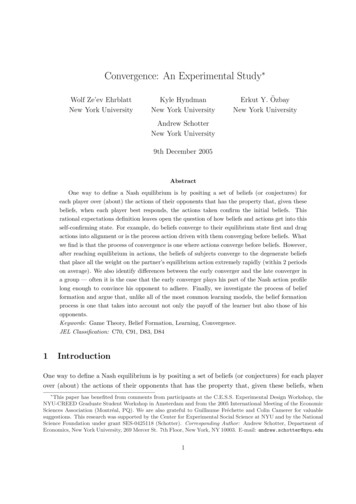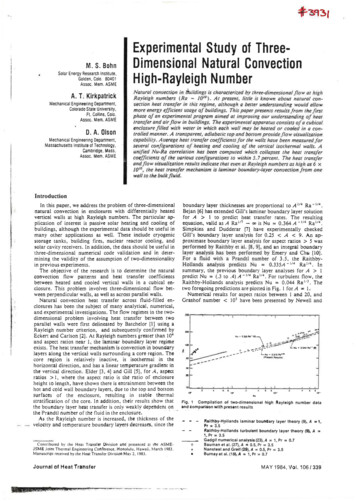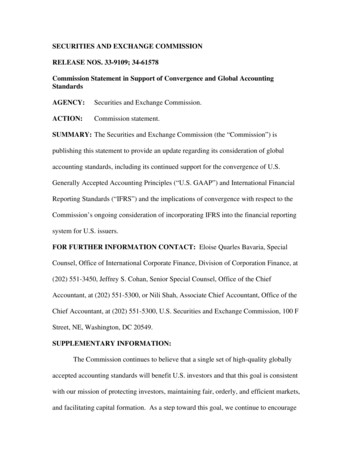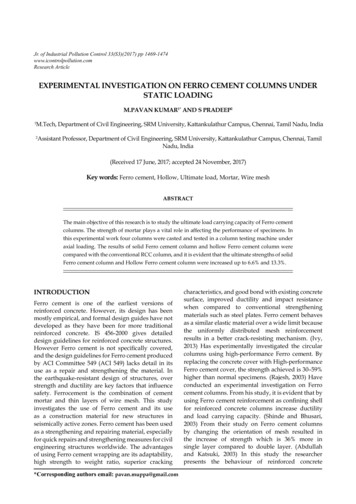
Transcription
Convergence: An Experimental Study Wolf Ze’ev EhrblattNew York UniversityKyle HyndmanNew York UniversityErkut Y. ÖzbayNew York UniversityAndrew SchotterNew York University9th December 2005AbstractOne way to define a Nash equilibrium is by positing a set of beliefs (or conjectures) foreach player over (about) the actions of their opponents that has the property that, given thesebeliefs, when each player best responds, the actions taken confirm the initial beliefs. Thisrational expectations definition leaves open the question of how beliefs and actions get into thisself-confirming state. For example, do beliefs converge to their equilibrium state first and dragactions into alignment or is the process action driven with them converging before beliefs. Whatwe find is that the process of convergence is one where actions converge before beliefs. However,after reaching equilibrium in actions, the beliefs of subjects converge to the degenerate beliefsthat place all the weight on the partner’s equilibrium action extremely rapidly (within 2 periodson average). We also identify differences between the early converger and the late converger ina group — often it is the case that the early converger plays his part of the Nash action profilelong enough to convince his opponent to adhere. Finally, we investigate the process of beliefformation and argue that, unlike all of the most common learning models, the belief formationprocess is one that takes into account not only the payoff of the learner but also those of hisopponents.Keywords: Game Theory, Belief Formation, Learning, Convergence.JEL Classification: C70, C91, D83, D841IntroductionOne way to define a Nash equilibrium is by positing a set of beliefs (or conjectures) for each playerover (about) the actions of their opponents that has the property that, given these beliefs, when This paper has benefited from comments from participants at the C.E.S.S. Experimental Design Workshop, theNYU-CREED Graduate Student Workshop in Amsterdam and from the 2005 International Meeting of the EconomicSciences Association (Montréal, PQ). We are also grateful to Guillaume Fréchette and Colin Camerer for valuablesuggestions. This research was supported by the Center for Experimental Social Science at NYU and by the NationalScience Foundation under grant SES-0425118 (Schotter). Corresponding Author: Andrew Schotter, Department ofEconomics, New York University, 269 Mercer St. 7th Floor, New York, NY 10003. E-mail: andrew.schotter@nyu.edu1
each player best responds the actions taken confirm the initial beliefs. This rational expectationsdefinition leaves open the question of how beliefs and actions get into this self-confirming state.For example, do beliefs converge to their equilibrium state first and drag actions into alignmentor is the process action driven with them converging before beliefs? One thing we have learned inour work is that people do not arrive at the equilibrium play of a game by a process of deductivereasoning but rather by induction, observation and learning as the game is iterated. They convergeto it as time passes rather than leaping to it spontaneously after a logical reasoning process. Alongthe path of this convergence we also know that in some learning models people are forward lookingand make conjectures (form beliefs) about what their opponent is likely to do.1In this paper we investigate the answers to the following questions:1) When people playing a finite strategy matrix game converge to the Nash equilibrium of thegame, assuming that the game has a unique pure-strategy equilibrium, do their actions convergefirst and then drag their beliefs into convergence or do their beliefs converge first and pull in theiractions?2) When the actions of players in these circumstances fail to converge to the Nash equilibrium,is it true that their beliefs converge but the players fail to best respond to them or is it simply thattheir beliefs fail to enter the best response region where the Nash equilibrium beliefs exist?3) In the final play of a repeated game that converges to a unique pure-strategy Nash equilibriumdo the players typically place all the probability mass on the equilibrium strategy of the other playeror are they still unsure of what he or she is going to do? If the probability distribution is degenerate,how long does it take to get there after actions have exhibited the Nash equilibrium pattern?4) Do the answers to questions 1-3 above change when the game played can be solved by theiterative elimination of dominated strategies? Do games that are dominance solvable convergefaster than those that are not and do beliefs or actions get to equilibrium first?5) Is there a consensus across people on the belief formation process, i.e., if we showed the timeseries of play of a simple two-person game to a set of people and asked them to state their beliefsabout how the players are expected to play, would the belief formation process look similar acrossthe observing agents? In other words, do people tend to form their beliefs in a similar way holdingthe play of the game they are watching constant?6) Are existing learning models that do not include the payoff received by both players descriptiveof how people form beliefs?The answers to these questions are not readily available in the existing literature. The reasonis that we do not have a good description of how people converge to the equilibrium of games evenwhen those equilibria are unambiguously defined, i.e. unique, and easily approachable logically1Of course some learning models, such as reinforcement learning, are totally backward looking and do not involvethe use of beliefs. Still most of the commonly used learning models can be reinterpreted as belief learning models asCamerer and Ho (1999) indicate in their description of the EWA model which nest belief learning as a special case.2
(e.g., can be arrived at by a process of iterative deletion of dominated strategies).2This paper tries to answer these questions by having laboratory subjects play a set of twotwo-person 3 3 games for twenty periods while beliefs are elicited from them as they play. Both3 3 games played have a unique pure strategy equilibrium. In one game the equilibrium isdominance solvable while in the other it is not. We chose these games because we expected playto converge to the pure Nash equilibrium (as opposed to games where the equilibrium is only inmixed strategies) and hence the combination of observing actions and beliefs could be informativeabout the convergence process. After having 32 pairs play one of these games we selected one pairand their associated time series from the dominance-solvable (DSS) and non-dominance solvable(nDSS) game experiments that either converged or did not (DSS.c, DSS.nc, nDSS.c and nDSS.nc)and brought in new subjects to play a “prediction game” in which they were paid, period by period,to predict the next action in these time series.What we find is that in answer to Question 1, actions converge faster than beliefs. While wewill formally define what we mean by this in the next section of the paper, suffice it to meanwhat it says, on the way to convergence people do not hold “equilibrium beliefs” before they playequilibrium actions. Rather they seem to need an exhibition of equilibrium play in order to believethat the Nash equilibrium is likely to occur. This exhibition is typically given by one of the players,whom we will call the “early converger.” Specifically, the early converger plays his/her part ofthe Nash equilibrium for several periods even when the Nash action is not a best response to thebeliefs held at the time. For this player actions clearly converge before beliefs. The other player,the “late converger,” seeing the Nash actions played, alters his or her behavior after a while andconforms to Nash as well but the beliefs of the late converger almost simultaneously converge alongwith his or her actions. After both players play the Nash, in answer to Question 3, beliefs quicklybecome degenerate. These patterns do not differ much when we compare dominance solvable andnon-dominance solvable games.One striking finding of our experiment is related to Question 2 and to what occurs when playdoes not converge. Here it appears that for those games that do not converge beliefs rarely enter intothe set of beliefs for which the Nash strategy is a best response. In other words, non-convergenceof actions is equivalent to the failure of players to ever hold equilibrium beliefs even if, on occasion,they exhibit equilibrium actions. Non convergence appears to be the result of a failure in beliefsand not in the ability of players to best respond.In answering Question 5 we take advantage of a unique feature of our experimental design thatshows individuals the same time series of actions and elicits their beliefs period by period. Thisallows us to investigate whether people in general tend to update their beliefs in similar ways. Weknow of no other experiment in which this is done. What we find is that there is a good dealof consensus in the way people update their beliefs. One feature of this updating is that when2Nyarko and Schotter (2002a) elicit beliefs for the repeated play of games with mixed strategy equilibria but dueto the nature of the equilibrium play does not converge to the repeated play of one strategy there.3
updating observers appear to take account of the payoffs of both the player whose actions she ispredicting and the payoffs of his/her opponent. This feature is absent in just about all learningmodels such as reinforcement, fictitious play, and EWA learning models (see, for example, Erevand Roth (1998) and Camerer and Ho (1999)). Hence it goes a long way to explaining the stylizedfeatures of elicited belief time series seen in this paper as well as Nyarko and Schotter (2002a,b)where the elicited beliefs of subjects were very volatile, as opposed to the smooth looking beliefvectors expected from previous learning models.3 Two notable exceptions are the work of Stahl andWilson (1995) and Camerer et al (2002). The finding that there is a consensus in the way peopleupdate in these games (or at least how observers update) provides hope that we may one day createa convincing theory of belief formation which is behaviorally rich since without a consensus sucha theory would have to be based on psychological characteristics in an individual by individualmanner.In this paper we will proceed as follows. In Section 2 we define more precisely what we meanwhen we say that either beliefs or actions converge. In Section 3 we describe our experiment designand procedures, while in Section 4 we present the results of our experiments. In Section 5, we arguethat there is a consensus in the belief formation process. We also identify many regularities that webelieve any reasonable model of belief formation must incorporate. Section 6 concludes the paper.Instructions can be found in Appendices A and B, while figures are collected in Appendix C.2Definition of ConvergenceConsider a finite strategy two person game Γ hN, Ai , πi i where N is the set of players indexedi 1,2, Ai is the set of actions for each player, and πi is player i’s payoff function which mapsA1 A2 into a set of real valued payoffs. Assume that this game is to be played T times and thatΓ has a unique pure strategy Nash equilibrium a (a 1 , a 2 ), a 1 A1 , a 2 A2 whose payoffs arenot Pareto dominated by any other payoffs in the game. In such a case we would expect that a would remain the unique pure strategy equilibrium even for the T times repeated play of Γ andthat such an equilibrium would be sub-game perfect in the repeated game. We will call a i playeri’s Nash action. Let ht [(a11 , a12 ) . . . (at1 , at2 )] be a history of actions in the play of Γ over the firstt periods of play.Let Tia : {t0 T 2 ati a i t0 t T }. Now we can define the notion of convergence inactions to Nash equilibrium at period t.Definition 1. Player i converges in actions to Nash equilibrium in period t̄ if Tia 6 and t̄ mint0 Tia t0 . Such t̄ will be called the convergence period of actions. If Tia then we will say thatplayer i does not converge in actions to Nash equilibrium.4In other words, player i converges to Nash equilibrium in period t̄ if this is the earliest period in34See Nyarko and Schotter (2002b) for an elaboration of this point.We will sometimes omit the words “to Nash equilibrium.”4
which player i has played her Nash action and continued to play her Nash action from that perioduntil the end of the game. If there is no such period, it means that the player did not play herNash action consistently up to period T and thus did not converge. Notice that we put an upperbound on the convergence period, T 2 , since we do not want to consider a player as converged inperiod T if that player chose her actions randomly and the action chosen in period T just happenedto be her Nash action. While using the upper bound of T 1 would have been sufficient, we havedecided to be more conservative in our definition of convergence in actions and defined the upperbound as T 2.We will say that a game has converged in actions to Nash equilibrium if there are t 1 , t 2 suchthat player 1 has converged in actions in period t 1 and player 2 has converged in actions at periodt 2 .If player j has K actions then define the K dimensional simplex i [0, 1]K for player i asher beliefs simplex where bti i defines a K dimensional belief vector at time t for player i;Ptthat is, Kk 1 bi,k 1. Bi i is that subset of beliefs for player i for which her best responseto any vector of beliefs in Bi is to play her part in the Nash equilibrium, i.e., a i argmaxai AiPk ) b B . Let 1 , b1 ).(bt , bt )] be a belief history defining the beliefs heldbπ(a,ab [(biit1 21 2k i,k i i jby the two players at each point in the history of the game up to period t.We will define convergence in beliefs similar to the way we defined convergence in actions. Firstdefine Tib : {t0 T 1 bti Bi t0 t T }. Next define convergence in beliefs.Definition 2. Player i converges in beliefs to Nash equilibrium in period t̃ if Tib 6 and t̃ mint0 T b t0 . Such t̃ will be called the convergence period of beliefs. If Tib then we will say thatiplayer i does not converge in beliefs to Nash equilibrium.A game will be said to have converged in beliefs if there are t 1 , t 2 such that player 1 has convergedin beliefs in period t 1 and player 2 has converged in beliefs at period t 2 .3Experimental Design and ProceduresIn order to answer the questions posed in the beginning of this paper, we conducted two experiments — the first of which we call the AB experiment (actions and beliefs) and the second, theB experiment (beliefs only). Both experiments were conducted in the laboratory of the Center forExperimental Social Science at New York University. All the participants were NYU undergraduatestudents recruited via e-mail. Participants received a 7 show-up fee in addition to the gains fromthe experiment. Each experiment session took about 1.5 hours to complete. The number of participants in the AB experiment and the B experiment were 64 and 53, respectively, and the averagepayoff in each experiment was 19.7 and 20.9. All the sessions were run using the experimentalprogram z-Tree by Urs Fischbacher (1999).5
3.1The AB ExperimentIn the AB experiment subjects played the two 3 3 games shown in Figure 1. Note that each gamehas a unique pure-strategy equilibrium but that the game in Figure (1.a) is dominance solvablewhile the game in Figure (1.b) is not dominance solvable. Each game was played for 20 periodswith a fixed partner but partners were randomly switched when the game changed. Also, the roleof each player was randomly determined. There were four sessions in the AB treatment with theorder of the games presented to subjects changing in each one.The games chosen had the following features: A unique Nash equilibrium in pure strategies in the stage game. Nash payoffs are on the Pareto frontier. Payoffs in the Nash equilibrium were not symmetric.These properties insured that there was a unique sub-game perfect equilibrium to the 20-periodrepeated game the subjects played in the lab in which they play the stage-game Nash equilibriumin each period.At each period, the subjects were asked to make 2 decisions. The first was to choose the actionfor that period. The second was to state their beliefs regarding their partner’s action in thatperiod.5 The action decision was rewarded according to the relevant game matrix, while the beliefspredictions were rewarded using the Quadratic Scoring Rule (QSR).6 All payoffs from the actionchoices and the belief predictions were then summed up to give subjects their final payoff.3.2The B ExperimentThe AB experiment produced a set of action choices, some converging to the Nash equilibria whileothers not. In the B experiment new subjects were recruited and brought into the lab. In frontof the room there was a screen upon which the period-by-period play of one pair of subjects whoplayed the game in the AB treatment was projected. In other words, we took the time series ofactions of a pair in the AB experiment and played it out period by period. In the instructions, thesubjects were informed that the games they were about to see were played in the past by NYUundergraduates so that ambiguity regarding the population will be eliminated. The subjects were5While the game subjects face is a repeated one, the beliefs elicited here are only for one period.Under the assumption the subjects are risk neutral, the use of the QSR should make the subjects state their truebeliefs regarding their opponent’s action. Sonnemans and Offerman (2001) find that the QSR is incentive compatibleand that subjects tend to report their true beliefs when the QSR is used. Nyarko and Schotter (2002a) also use aquadratic scoring rule and offer substantial evidence that subjects best respond to the beliefs they state. Moreover,Wilcox and Feltovich (2000) report that belief elicitation does not always affect subjects’ behaviour. However,Rutström and Wilcox (2004) argue that the act of solicitation may focus the attention of the subject on his or herbeliefs in a way that may be unnatural.66
shown the time series of 2 games (DSS and nDSS). Their task was to predict the actions of one ofthe players in this game for 20 periods as the actions in the time series were revealed to them periodby period. Predictions were rewarded with the same QSR that was used in the AB experiment.Note that in this experiment subjects do not play a game but are spectators who were askedto make predictions, period by period, about the actions of one of the players whose behavior theywere observing. The nice feature of the experiment was that since all subjects observed the sametime series we are able to hold the actions observed constant and study the belief formation processof subjects observing the same set of actions. In all other belief elicitation experiments that weknow of, subject beliefs are elicited pair by pair so that the observed actions are not controlled.In our design, the actions observed by all subjects are held constant so we can study the beliefformation process in isolation and the consensus (if any) of observing subjects about beliefs.The only other experiments we know of where spectators were used were those of Offerman etal (1996) and Huck and Weizsäcker (2002). In the former experiment, spectators were matched toan actual player in a public goods experiment and asked to state beliefs on the contributions of theother group members. In the latter experiment, subjects were asked to predict a second group’schoice frequencies in a set of lottery-choice tasks. Our design differs from both of these settings byhaving many spectators view the same choice path and predicting the same player behavior ratherthan having one spectator be attached to one player.4ResultsIn this section and the next we report the results of our experiments by answering the six researchquestions stated in the introduction.Question 1: When people playing a finite strategy matrix game converge to theNash equilibrium of the game, assuming that the game has a unique pure-strategyequilibrium, do their actions converge first and then drag their beliefs into convergenceor do their beliefs converge first and pull in their actions?Despite the fact that each game our subjects played had a unique pure strategy equilibrium,there was a significant failure on the part of subjects to reach it. Using the definition of convergencein Section 2, we categorized each pair in each game as either converging or non-converging. In thedominance-solvable game only 17 of 32 pairs converged, while in the non-dominance solvable game16 of 32 pairs converged.Regarding the relative speed of convergence of beliefs and actions, Table 1 provides clear evidence that actions converged before beliefs in both the dominance solvable and the non-dominancesolvable games. For example while, on average, in the dominance solvable game it took 5 periodsfor players to reach the Nash equilibrium action, their beliefs did not converge until 7.7 periods.7
For non-dominance solvable games the comparable numbers are 7 and 8.7.7 The results, in theTable 1: Summary Statistics: Convergent PairsDSSnDSSNumber of pairs17 (of 32) 16 (of 32)Mean period of convergence in actions5.07.0Mean period of convergence in beliefs7.78.7column labeled “All” in Table 2, of the paired t-test clearly show that beliefs converge after actionsfor both game types.8 However, note that looking at the data at this level of aggregation masks animportant distinction between so-called early convergers and late convergers that we discuss below.Table 2: Results of the Paired t-test (H0 : Beliefs andDSSAllEarlyMean: Conv Period of Beliefs 2.715.70minus Conv Period of Actionst-statistic4.034.54p-value 0.001 0.001Number of Observations3413Actions Converge Simultaneously)nDSSLate AllEarlyLate0.69 1.723.43-0.141.060.16133.75 0.001325.16 0.00114-0.460.6714“Early” uses only those subjects whose actions were first to converge (in a group), while “Late” uses onlythose subjects whose actions converged second (in a group). In the case of simultaneous convergence, thepair was excluded.It appears that the process of reaching equilibrium is an action-led process. Pairs do not seemto reach equilibrium by first having their beliefs reach the Nash best response set and then replyingappropriately. Rather subjects seem to need proof that their opponent knows what an equilibrium isbefore they will choose the equilibrium action themselves. Only after this do their beliefs converge.This creates a problem for convergence, however, since if each player is waiting to observe theiropponent play the equilibrium action before they do, it would seem as if it would be difficult, if notimpossible, to converge. This standoff can only be resolved if one player leads the way and actsfirst. We call such players “early convergers” (teachers).To illustrate the difference between early and late convergers consider Figure 2. For both earlyand late convergers, this figure plots the histogram of the difference between the action convergenceperiod and the beliefs convergence period. A very clear pattern emerges: early convergers’ actionsalmost always converge before beliefs (in fact there are no negative differences), while for lateconvergers two things are noticeable. First, the difference between when the actions and beliefsconverge is much smaller for these subjects. For example, in the DSS game, while the mean7In Table 1 we allowed for final period deviations so long as a clear pattern of convergence emerged beforehand.For example, we labeled a subject as converging if from period 10 to 19 the subject played his/her Nash strategy butdefected in period 20.8Results are the same for the Wilcoxon Signed-Rank test and are not reported here.8
difference between when actions and beliefs converged for the early convergers was 5.7 periods itwas only 0.69 periods for late convergers; a similarly stark difference arises is the nDSS game aswell. This is not a surprise since, often times, the early convergers are leading the way and waitingfor their opponent to converge. While they are waiting their beliefs are outside of the Nash bestresponse set. Second, while for early convergers in either of our games beliefs always convergedafter actions, this was not true for 7 of 16 followers in the nDSS game and 2 of 17 in the DSS game.The results of a paired t-test in the columns “Early” and “Late” in Table 2 lend further support toour claim that early convergers’ beliefs converge after their actions, while late convergers’ actionsand beliefs converge almost simultaneously.This suggests that teaching and learning happen in the games that converged. One playerunderstands what the equilibrium is in the game and plays it for the rest of the session. The earlyconverger sticks with her action even though it is not a best response to her beliefs in order toinfluence her partner’s beliefs, assuming that he will eventually choose the Nash action. Convergence in actions takes some time for the early converger’s opponent and thus her beliefs convergeafter the actions. Meanwhile, the late converger sees that his opponent has chosen the same actionfor consecutive periods and the realization of the Nash equilibrium occurs at the same time as theconvergence of the beliefs. Thus beliefs and actions converge in, roughly, the same period.Remark 1. What we have just discussed may be loosely thought of as successful teaching. Thatis, one of the players saw the Nash equilibrium, began to play it, despite it not being a bestresponse to his/her beliefs, until eventually his/her opponent also played the Nash action and thegame converged. However, there are also many instances of unsuccessful teaching episodes. Forexample, approximately 30% of the players not part of a pair that converged to Nash equilibriumactually played their Nash equilibrium strategy for three or more consecutive periods. Moreover,it was usually the case that their beliefs lied outside of the Nash Best-Response region — perhapsindicating a desire to teach the other player the Nash equilibrium. Of course, what makes suchepisodes unsuccessful is the fact that her opponent did not choose his Nash action. Eventually,this teacher simply gave up on playing her Nash strategy and the game did not converge to Nashequilibrium.4.1Early Convergers: A DigressionFrom our discussion above, there appear to be substantial differences between early and late convergers. We would like to know why some players converge on their Nash action relatively earlyand others converge on their Nash action relatively late. One may conjecture that the strategicrole you play (i.e. Row or Column) is a causal factor in determining whether you are likely to bean early converger. Beyond this conjecture, one might ask, for dominance solvable games, does theearly converger tend to be the player with fewer steps of iterated elimination of strategies? (Theidea here being that he or she may be more able to see where the eventual equilibrium is.) Finally,how many periods are their between the convergence of the early and late convergers?9
The answers to these questions are not very informative. First, we find that half of the earlyconvergers are column players and the other half are row players. In other words, your strategicrole in the game has little to do with whether you converge first or second. This is true for both theDSS and nDSS games. This also answers our second question since if both row and column playerare equally likely to be converge first, then the number of iterated steps of elimination they facecan not be a factor. Finally, it appears as if late convergers recognise the Nash equilibrium quitequickly after his opponent has converged on her Nash action: on average, late convergers play theNash equilibrium 2.8 periods later.9This discussion leaves us with a very unclear idea what differentiates between those that convergeearly and those that converge late. However, we offer the following conjecture which is that it isthe subject whose payoff is below his or her expectations that ultimately converges first to his/herNash action. More precisely, say that you and I are playing a game and each period, given yourexpectations about me, you are pleasantly surprised by my actions in that your payoff often exceedsyour expected payoff while just the opposite it true for me. In such a case we might expect that theperson who is getting the short end of the expectational stick will look more closely at the gameand try to lead her opponent to the Nash equilibrium where, in both of the games we used, eachplayer does rather well. In this sense, we may view the early converger as a teacher.To investigate this conjecture we calculate the ratio of the actual payoffs (AP) that playersreceived to their expected payoffs (EP), given their elicited beliefs, in the periods before convergence(or the periods before the early converger played Nash); we denote this ratio byAPEP .The motivationfor this exercise is as follows. If a player’s actual payoff is lower than her expected payoff, then shemay devote more attention to learn about the game. Note, however, that an important differencebetween dominance solvable and non-dominance solvable games may arise. In the former, a playermay learn that one or more strategies is dominated, and this may help her find her Nash strategy.However, in a non-dominance solvable game, she may simply learn how to best respond to herbeliefs (or to her opponent’s actions), which will not necessarily lead her to her Nash strategy. Inthis way, we may expect that theAPEPratio will be significantly lower for ea
each player best responds the actions taken conflrm the initial beliefs. This rational expectations . (DSS) and non-dominance solvable (nDSS) game experiments that either converged or did not (DSS.c, DSS.nc, nDSS.c and nDSS.nc) . (1995) and Camerer et al (2002). The flnding that there i











